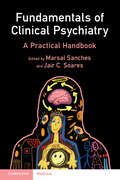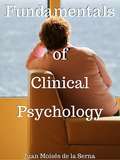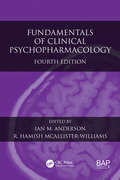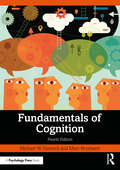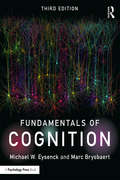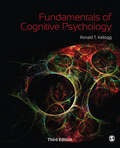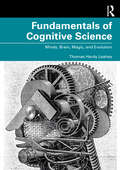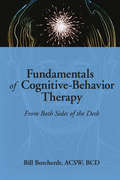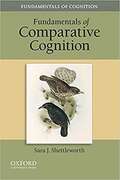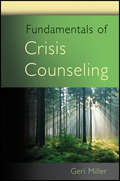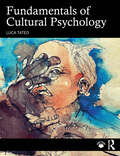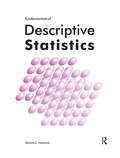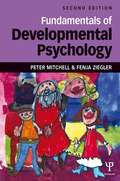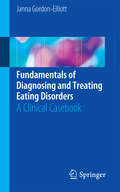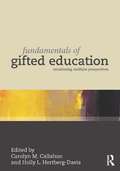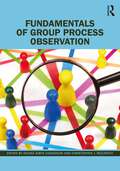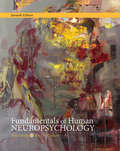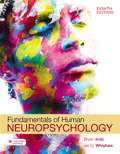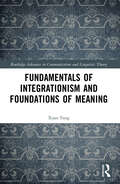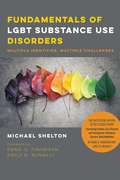- Table View
- List View
Fundamentals of Clinical Psychiatry: A Practical Handbook
by Jair C. Soares Marsal SanchesA practical handbook providing a succinct overview of the different aspects of mental health disorders, facilitating a solid base knowledge of the field of psychiatry. Offering a systematic, straightforward approach, the book covers the importance and relevance of mental health disorders, their causes, presentation, and the best approaches for their treatment. Written by mental health professionals with a high level of expertise and practical experience in the treatment of patients with mental health issues, the book includes numerous clinical vignettes, bulleted lists, tables, diagrams, and algorithms to facilitate understanding. It covers the important topics across psychiatry, including the psychiatric interview; psychosocial theories and their implications for psychiatry; neurostimulation treatments; the suicidal patient; and dementias, as well as full coverage of the depressive, bipolar, anxiety, and psychotic disorders. Essential reading for medical students, trainees in psychiatry, and other healthcare professionals interested in expanding their knowledge of psychiatry and mental health.
Fundamentals of Clinical Psychology
by Juan Moisés de la SernaClinical Psychology is one of the most chosen professional job prospects for professionals studying Psychology career, in which they focus their psychological attention on people showing or not psychopathologies. Equally, clinical psychology is well known for the general audience about psychologist's labor, area which is every day wider because of the great benefits of counting on professionals specialized in knowing the way people feel, think and behave.
Fundamentals of Clinical Psychopharmacology
by Peter Whelan Peter Lydyard Michael FangerThis book provides up-to-date, evidence-based and unbiased information about psychopharmacology. It spans the range of the discipline, from mode of action and side effects of drugs to meta-analyses of clinical trials. This latest edition is fully updated and provides the key facts about currently used psychotropic drugs, set in the context of the neuroscience of the disorders they treat. It also includes a new chapter on the principles of psychiatric prescribing. Key references are provided at the end of each chapter along with suggestions for further reading.
Fundamentals of Cognition
by Michael W. Eysenck Marc BrysbaertIs it possible to learn something without being aware of it? How does emotion influence the way we think? How can we improve our memory? Fundamentals of Cognition, Fourth Edition, provides a basic, reader-friendly introduction to the key cognitive processes we use to interact successfully with the world around us. Our abilities in attention, perception, learning, memory, language, problem solving, thinking, and reasoning are all vitally important in enabling us to cope with everyday life. Understanding these processes through the study of cognitive psychology is essential for understanding human behaviour. This edition has been thoroughly updated and revised with an emphasis on making it even more accessible to introductory-level students. This new edition includes: updated references for readers who are looking for more detailed information; checks to make sure that statements made in the previous version are still valid, given recent findings on replication issues; extended research activities and "In the Real World" case studies to make it easy for students to engage with the material; real-world topics such as discussions of attention-deficit/hyperactivity disorder, the reading problems of individuals with dyslexia, why magic tricks work, and why we cannot remember the Apple logo accurately; an extensive set of "Key term" definitions; supporting Instructor and Student Resources containing multiple choice questions, flashcards, simulations of key experiments, and instructor resources. The book provides a perfect balance between traditional approaches to cognition and cutting-edge cognitive neuroscience and cognitive neuropsychology. Covering all the key topics within cognition, this comprehensive overview is essential reading for all students interested in psychology.
Fundamentals of Cognition
by Michael W. Eysenck Marc BrysbaertIs it possible to learn something without being aware of it?How does emotion influence the way we think?How can we improve our memory? Fundamentals of Cognition, third edition, provides a basic, reader-friendly introduction to the key cognitive processes we use to interact successfully with the world around us. Our abilities in attention, perception, learning, memory, language, problem solving, thinking, and reasoning are all vitally important in enabling us to cope with everyday life. Understanding these processes through the study of cognitive psychology is essential for understanding human behaviour. This edition has been thoroughly updated and revised with an emphasis on making it even more accessible to introductory-level students. Bringing on board Professor Marc Brysbaert, a world-leading researcher in the psychology of language, as co-author, this new edition includes: developed and extended research activities and "In the Real World" case studies to make it easy for students to engage with the material; new real-world topics such as discussions of attention-deficit/hyperactivity disorder, the reading problems of individuals with dyslexia, why magic tricks work, and why we cannot remember the Apple logo accurately; a supporting companion website containing multiple choice questions, flashcards, sample essay answers, instructor resources, and more. The book provides a perfect balance between traditional approaches to cognition and cutting-edge cognitive neuroscience and cognitive neuropsychology. Covering all the key topics within cognition, this comprehensive overview is essential reading for all students of cognitive psychology and related areas such as clinical psychology.
Fundamentals of Cognitive Neuroscience: A Beginner's Guide
by Bernard Baars Nicole M. GageFundamentals of Cognitive Neuroscience, winner of a 2013 Most Promising New Textbook Award from the Text and Academic Authors Association, offers a comprehensive and easy-to-follow guide to cognitive neuroscience. Chapters in this introductory text cover all aspects of the field-the neural framework, sight, sound, consciousness, learning/memory, problem solving, speech, executive control, emotions, socialization and development-in a student-friendly format with extensive pedagogy and ancillaries to aid both the student and professor. Throughout the text, case studies and everyday examples are used to help students understand the more challenging aspects of the material. Written by two leading experts in the field, the text takes a unique thematic approach, guiding students along a clear path to understand the latest findings whether or not they have a background in neuroscience.
Fundamentals of Cognitive Psychology
by Ronald T. KelloggWith its reader-friendly style, this concise text offers a solid introduction to the fundamental concepts of cognitive psychology. Covering neuroimaging, emotion, and cognitive development, author Ronald T. Kellogg integrates the latest developments in cognitive neuroscience for a cutting-edge exploration of the field today. With new pedagogy, relevant examples, and an expanded full-color insert, the Third Edition is sure to engage students interested in an accessible and applied approach to cognitive psychology.
Fundamentals of Cognitive Psychology
by Ronald T. KelloggWith its reader-friendly style, this concise text offers a solid introduction to the fundamental concepts of cognitive psychology. Covering neuroimaging, emotion, and cognitive development, author Ronald T. Kellogg integrates the latest developments in cognitive neuroscience for a cutting-edge exploration of the field today. With new pedagogy, relevant examples, and an expanded full-color insert, the Third Edition is sure to engage students interested in an accessible and applied approach to cognitive psychology.
Fundamentals of Cognitive Science: Minds, Brain, Magic, and Evolution
by Thomas Hardy LeaheyFundamentals of Cognitive Science draws on research from psychology, philosophy, artificial intelligence, linguistics, evolution, and neuroscience to provide an engaging and student-friendly introduction to this interdisciplinary field. While structured around traditional cognitive psychology topics, from attention, learning theory, and memory to information processing, thinking, and decision making, the book also looks at neural networks, cognitive neuroscience, embodied cognition, and magic to illustrate cognitive science principles. The book is organized around the history of thinking about the mind and its relation to the world. It considers the evolution of cognition and how it demonstrates how our current thinking about cognitive processes is derived from pre-scientific philosophies and common sense, through psychologists’ empirical inquiries into mind and behavior as they pursued a science of cognition and the construction of artificial intelligences. The architectures of cognition are also applied throughout, and the book proposes a synthesis of them, from traditional symbol system architectures to recent work in embodied cognition and Bayesian predictive processing. Practical and policy implications are also considered but solutions are left for the readers to determine. Using extended case studies to address the most important themes, ideas, and findings, this book is suitable for upper-level undergraduate and graduate courses in psychology and related fields. It is also suitable for general readers interested in an accessible treatment of cognitive science and its practical implications. Please visit www.fundamentalsofcognitivescience.com for further resources to accompany the book.
Fundamentals of Cognitive-Behavior Therapy: From Both Sides of the Desk
by Bill Borcherdt Carlton MunsonA central premise of cognitive-behavior therapy is that individuals bring themselves to their emotions and behavior by how they think. Fundamentals of Cognitive-Behavior Therapy helps therapists and counselors address the important questions of cognitive-behavior therapy--what to ask, how to respond to difficult exchanges with clients, and why to make chosen responses--and helps them get at the cognitive base of clients’emotional disturbances more quickly. The book is unique in that it presents more than a textbook approach to problemsolving; it provides a wealth of data and philosophy that enables clinicians to respond more helpfully to client problems. Readers of Fundamentals of Cognitive-Behavior Therapy learn what therapeutic questions to ask and what responses to give to psychotherapy clients’common difficult questions and statements in ways that better contribute to the long-range happiness and survival of the client. This insightful book encourages therapists to help clients help themselves by showing therapists effective, detailed, responses that help clients answer their own questions and come to their own conclusions about why they react certain ways to specific situations. Among the 164 troublesome client questions and statements to which Borcherdt offers rational responses are:“But I don't feel like it.”“I can't make a decision, because I don't know if it is the right one.”“Why won't things work out for me?”“I can't help it.”“I have so many problems and feelings that I don't know where to begin dealing with them.”“Why don't I change? Why do I keep goofing up?”“Whose side are you on anyway?”Through this detailed look at the therapist's role in heightening client awareness of self, Author Bill Borcherdt, who has thirty years’experience as a therapist, provides a storehouse of practical, hands-on tact and tactics which encourages a problem-solving focus while preventing conversational drifting. He gives readers insights on:basic principles of emotional reeducation and well-beingpsychotherapy as teachingovercoming emotional disturbance tendenciesgetting individuals to answer their own questions so they can expose their own potential solutionsunderstanding and overcoming clients’resistance to changea client-centered method of problem-solving interviewingThe book illustrates that the primary medium of the therapist's influence is funneled through both direct questions asked of the client and through the therapist's responses to client questions and commentary. Suggested questions and responses in the book help practitioners prepare for interviews and better understand clients’resistance to change. Designed for students in training as well as the beginning or seasoned practitioner, Fundamentals of Cognitive-Behavior Therapy includes 172 rational questions and 164 rational responses, each with commentary that shows the clinical justifications for asking these questions and offering these responses.Social workers, psychologists, guidance counselors, psychiatrists, nurses in mental health settings, marital/family counselors, alcohol and other drug abuse counselors, and other human service professionals will find Fundamentals of Cognitive-Behavior Therapy filled with practical and insightful guidelines for better helping their psychotherapy clients.
Fundamentals of Comparative Cognition (Fundamentals in Cognition)
by Paul Bloom Lynn Nadel Sara J. ShettleworthA foremost scholar in comparative cognition--a discipline closely connected to behavioral biology, evolution, and cognitive neuroscience--author Sara J. Shettleworth delivers a focused treatment of the essentials in writing that is both lucid and captivating. <p><p> Brief, yet brimming with detail, Fundamentals of Comparative Cognition conveys the richness and complexity of this diverse field while addressing two fundamental questions: "What makes us uniquely human?" and "What do our minds share with other creatures?"
Fundamentals of Crisis Counseling
by Geri MillerAn indispensable handbook for assisting clients in crisis and in their journey toward healing Integrating practical training with both research and theory, Fundamentals of Crisis Counseling offers students and professionals proven hands-on techniques to assist clients in recovery from crisis and towards an eventual return to their day-to-day lives. Written in the author's gentle yet purposeful voice, this reader-friendly guide is filled with lessons on current evidence-based counseling, how to operate as a client stress manager, and information on finding resources that facilitate client resilience. In addition, the author helps counselors improve counseling effectiveness by gaining a better understanding of their own strengths and weaknesses and emphasizes the importance of self-care. Stemming from the author's thirty-five years of experience as a crisis counselor, this book contains valuable information on: Crisis theory and intervention models Concepts, techniques, assessment, and treatment for disaster mental health work Legal and ethical concerns regarding working with individuals, groups, couples, and families Assessment and instrument selection Main concepts and techniques of brief therapy, motivational interviewing, stages of change, positive psychology, grief therapy, client resilience, and spirituality Multicultural crisis counseling techniques centered on age, gender, sexual orientation, and ethnicity Counselor self-care complete with case studies and examples Ideal for all mental health professionals looking for guidance on best practices in crisis counseling, this book is also suitable for training professionals and counseling students. The book includes access to an online instructor's test bank, PowerPoint slides, and syllabi in line with 2009 Council for Accreditation of Counseling and Related Educational Programs (CACREP) standards. Fundamentals of Crisis Counseling imparts useful knowledge on little utilized crisis counseling abilities, preparing counselors at every stage to effectively respond to the immediate and lasting affects of crisis.
Fundamentals of Cultural Psychology
by Luca TateoThis innovative textbook is the ideal introduction to cultural psychology. It focuses on a holistic approach, which emphasizes that culture is created and shared by minds and society.Organized around short core concept chapters, the book encourages students to think critically about culture and the theories around it. Chapters explore what cultural psychology is and its forms of knowing, how cultural psychology can be used to understand higher psychological functions, and the human psyche as a whole. Each chapter contains definitions of key concepts, real-world examples from everyday human activities, reflection questions, short biographies of key figures relevant to cultural psychology, and chapter summaries. There are also links to video interviews from leading international scholars which provide critical reflections on core concepts in cultural psychology.This is the essential introductory book for students of cultural psychology, as well as cultural studies and anthropology. It will be useful for anyone looking to learn more about the history of ideas, the human mind, and its historical and material relationship with culture.
Fundamentals of Descriptive Statistics
by Zealure C Holcomb• Do your students need to organize and summarize data for term projects? Will they need to perform these tasks on the job? This book gives them thorough preparation. • In twelve short chapters, your students will learn the purposes of descriptive statistics, their calculation, and proper interpretation. • Actual data on the emotional health of foster-care adolescents are used throughout the book to illustrate various ways of deriving meaning from the data with descriptive statistics. Other interesting examples are also included. • Computational procedures are illustrated with step-by-step, easy-to-follow examples. • End-of-chapter exercises provide ample practice for students to master both computations and statistical concepts. • Eliminates the need for students to buy a traditional statistics book that emphasizes inferential statistics. • Thoroughly field-tested for student comprehension. • This book will please you and your students with its clarity of presentation. • Outstanding supplement for students who need to describe term project data.
Fundamentals of Developmental Psychology
by Peter Mitchell Fenja ZieglerThis new edition of the highly successful Fundamentals of Development: The Psychology of Childhood has been thoroughly revised and updated to reflect the exciting new findings in the thriving area of developmental psychology. The book addresses a number of fascinating questions including: Are children born good or bad? What do children understand about the mind? What roles do nature and nurture play in child development? As in the previous edition, the book follows a thematic approach and outlines the main areas of developmental psychology, including classic theories and studies, and offers a broad overview of contemporary research in the field. Each chapter addresses a key topic – such as theory of mind, attachment, and moral development - and is self-contained and comprehensive in its coverage. New chapters in this edition include a detailed look at methods in developmental psychology, an overview of developmental disorders, and an introduction to the burgeoning area of numerical development. The book is student-friendly, with all topics described in straightforward language, illustrated in full colour, and organized as standalone chapters. The text will make an excellent companion to introductory courses on developmental psychology, and for instructors there are high-quality lecture slides, and a bank of multiple choice questions. The text is written to be both accessible and comprehensive, and to provide an engaging overview for students and professionals who have little or no background in this area.
Fundamentals of Diagnosing and Treating Eating Disorders
by Janna Gordon-ElliottThis concise text contains clinical cases covering different types of dysfunctional eating with a focus on the eating disorders in the DSM-5, including the new disorder Avoidant-Restrictive Food Intake Disorder (ARFID). Each case will follow the format of clinical presentation, diagnosis, discussion, and suggested readings. The discussion sections will prioritize treatment and management, with practical tips for clinicians. The text will also include boxed "quick snapshots" with important fundamentals that are relevant to the case and the diagnosis or diagnoses being presented. Presentations that are common in clinical practice, but that may not fit neatly into one specific diagnostic category, will also be reviewed, with guidance on principles of assessment, prioritization of problems, formulation, and management. The book encourages the consideration of comorbidities and differential diagnosis. The structure of the book's content will give readers a head-start in honing their differential diagnosis skills in the area of eating disorders. The book is split into three categories, based on the most immediately visible features of the case: I. The person who eats too little, II. The person who eats too much, III. The person who eats in an odd or idiosyncratic way. For teaching purposes, several of the cases describe a "not normal" eating presentation that are not classified within one of the current definitions of a psychiatric disorder. Fundamentals of Diagnosing and Treating Eating Disorders is aimed at psychiatrists, primary care physicians, and other clinicians who may see patients with eating disorders.
Fundamentals of Forensic Victimology: Insights into Crime, Trauma, and Justice
by Monika Thakur Eric Lambert Chander Mohan GuptaThis edited volume delves into the multifaceted field of victimology, exploring its historical roots, theoretical frameworks, and contemporary applications. It navigates through various forms of victimization, from intimate violence to stranger violence, shedding light on their prevalence and underlying causes. With a focus on psychological aspects and victim profiling, it equips readers with insights crucial for understanding and addressing the impact of crime on individuals and society. Moreover, this book scrutinizes pressing issues such as sex trafficking and sexual offenses, offering comprehensive analyses and potential avenues for intervention. It also examines the role of forensic victimology in the legal arena, highlighting its significance in securing justice for victims. Ideal for scholars, practitioners, and students in criminology, psychology, and law, this book serves as an invaluable resource for anyone seeking a deeper understanding of victimization and its implications for society.
Fundamentals of Gifted Education: Considering Multiple Perspectives
by Carolyn M. Callahan Holly L. Hertberg-DavisThe field of gifted education is characterized by a confusing array of perspectives concerning such fundamental issues as definition, philosophy, curriculum, social and emotional development, and underserved populations. The mission of this book is to provide a coherent framework that instructors and service providers can use in planning effective programs, providing appropriate counseling services, and evaluating programs for the gifted. Most sections are organized around fundamental issues confronting the field and follow a common structure: an introductory chapter that provides historical and theoretical background and organizing questions followed by several point-of-view chapters written by experts that provide varied perspectives on the topic at hand. Distinguishing Features Comprehensive Coverage - The book's forty-five manageable-length chapters cover the full range of topics that must be considered in planning programs and services for gifted students both within and outside of school. Coherent Structure - Section introductions provide background information and organizing questions to guide chapter authors who provide varying views of the issue at hand. The emphasis is not on the "right way" or the "wrong way" (except when clearly documented bad practice is discussed), but on how best practice stems from well-informed and logical decision-making. Decision Making Focus - The book's introductory chapter addresses the need for a clearly developed and consistently applied set of values to guide decision making. Likewise, each section introduction includes a decision making framework regarding some aspect of educating, counseling, or parenting gifted students. This book is appropriate for introductory level courses in gifted education or courses in program development and planning. It is also suitable for school personnel responsible for making program planning decisions in the area of gifted education and for academic libraries with holdings in this area.
Fundamentals of Gifted Education: Considering Multiple Perspectives
by Carolyn M. Callahan Holly L. Hertberg-DavisThe field of gifted education is characterized by a perplexing array of perspectives concerning such fundamental issues as definition, identification, curriculum, social and emotional development, and underserved populations. Fundamentals of Gifted Education provides a coherent framework for planning effective programs, providing appropriate educational services, and evaluating programs for the gifted. Parts are organized around fundamental issues confronting the field and follow a common structure: an introductory chapter that provides an overview of the theme of that part as well as guiding points and questions for the reader followed by representative point-of-view chapters written by leading experts that provide varied perspectives on the topic at hand.
Fundamentals of Group Process Observation
by Devika Dibya ChoudhuriThis edited collection covers the role of the process observer – a position that enhances the effectiveness of group functioning by observing the process, summarizing the behavior of the group so that the group can learn and, if needed, improve its functioning. There is little guidance on best practices for this role, and in most settings, process observers are forced to rely on whatever previous training they have received in group work to fulfil their role. The first of its kind, this book offers a wealth of resources for the role of group process observer organized in a systematic way. Each contributor focuses on a specific aspect of group process observation, identifying what is currently known on the topic, suggesting best practices, and providing the reader with tools, structures, and guidelines for effective process observation. Students and educators of group-work courses will find this book integral as it covers the existing gap in literature on group-process observation.
Fundamentals of Human Neuropsychology
by Bryan Kolb Ian Q. WhishawWritten by two masterful researchers and educators, Fundamentals of Human Neuropsychology was the first textbook to introduce students to the scientific exploration of human behavior from a neuroscientist's perspective. With this updated edition, Bryan Kolb and Ian Whishaw again take students to the very forefront of one of the most eventful and impactful areas of scientific inquiry today, making an extraordinary amount of recent research and the real-world impact of those discoveries fascinating and accessible.
Fundamentals of Human Neuropsychology: Printed Test Bank
by Bryan Kolb Ian WhishawFundamentals of Human Neuropsychology continues to keep pace with its dynamic field, just as it has done throughout its nearly four decades of publication. As they have done since the first edition, the authors draw on recent research and their own clinical and lab experience to guide their development of the content, and on their experience in the classroom to help hone the presentation in a way that is both accessible and engaging to students. Coverage includes recent developments in network analysis, neural imaging, and genetic research—particularly in terms of the impact on our understanding and assessment of brain injury and disorders.
Fundamentals of Integrationism and Foundations of Meaning (Routledge Advances in Communication and Linguistic Theory)
by Xuan FangThis book looks at a long-standing question about "meaning" and the human experience — specifically, why meaning seems easy to recognize but hard to fully explain, especially from the perspective of integrationism.Fang’s book pins down the fundamentals of Roy Harris’s integrational linguistics and explores the relation between the nature of meaningfulness and human condition – the given features of human beings and human activities. The book rebuilds the main ideas behind the integrationist philosophy, placing them in the tradition of neo-Kantian, Fichtean phenomenology and existentialism. Fang also uses research from psychology, focusing on human-centred and developmental studies, to strengthen the arguments.The chapters review different theories of meaning, attributing the insurmountable obstacles encountered by the depersonalized – systemic, formalist, and decontextualized – approaches to their problematic philosophical presuppositions. The book also points to earlier thinkers who had important insights into language and communication, supporting an integrationist view of meaning.The text further pinpoints the foundations of meaning and its philosophical implications within the human context. It explains the vital importance of personalized and contextualized factors, and explores feasible ways of including those factors in theorizing to ultimately conclude that the nature of meaning is embedded in what we are as human beings.This book is a valuable read for anyone interested in integrationism, language theory, or the deeper questions about how meaning works.
Fundamentals of LGBT Substance Use Disorders: Multiple Identities, Multiple Challenges
by Michael SheltonIn this new book, the successor to the classic in the field Counseling Lesbian, Gay, Bisexual, and Transgender Substance Abusers: Dual Identities by Dana G. Finnegan and Emily B. McNally, Michael Shelton reviews the empirical literature and synthesizes what we know about the prevalence of LGBT substance use, abuse, and treatment availability, emphasizing the need for affirmative therapeutic practices. The principles of trauma-informed and culturally competent treatment/intervention are explained and assessed, as well as the challenges of minority stress and microaggressions experienced by the LGBT population. Separate sections focus on the sub-populations of lesbians, gay men, bisexuals, and transgender individuals. Separate chapters focus on LGBT youth, the elderly, family constellations and concerns, criminal justice issues, and LGBT rural substance abuse. This volume provides an introduction to the field that will be useful both as a primary textbook and as a handbook/reference for LGBT-focused and general substance-use disorder clinics and their administrators, clinicians, trainees, allies and volunteers.
Fundamentals of LGBT Substance Use Disorders: Multiple Identities, Multiple Challenges
by Michael Shelton?In this new book, the successor to the classic in the field Counseling Lesbian, Gay, Bisexual, and Transgender Substance Abusers: Dual Identities by Dana G. Finnegan and Emily B. McNally, Michael Shelton reviews the empirical literature and synthesizes what we know about the prevalence of LGBT substance use, abuse, and treatment availability, emphasizing the need for affirmative therapeutic practices. The principles of trauma-informed and culturally competent treatment/intervention are explained and assessed, as well as the challenges of minority stress and microaggressions experienced by the LGBT population. Separate sections focus on the sub-populations of lesbians, gay men, bisexuals, and transgender individuals. Separate chapters focus on LGBT youth, the elderly, family constellations and concerns, criminal justice issues, and rural LGBT substance abuse. This volume provides an introduction to the field that will be useful both as a primary textbook and as a handbook/reference for LGBT-focused and general substance-use disorder clinics and their administrators, clinicians, trainees, allies and volunteers.
